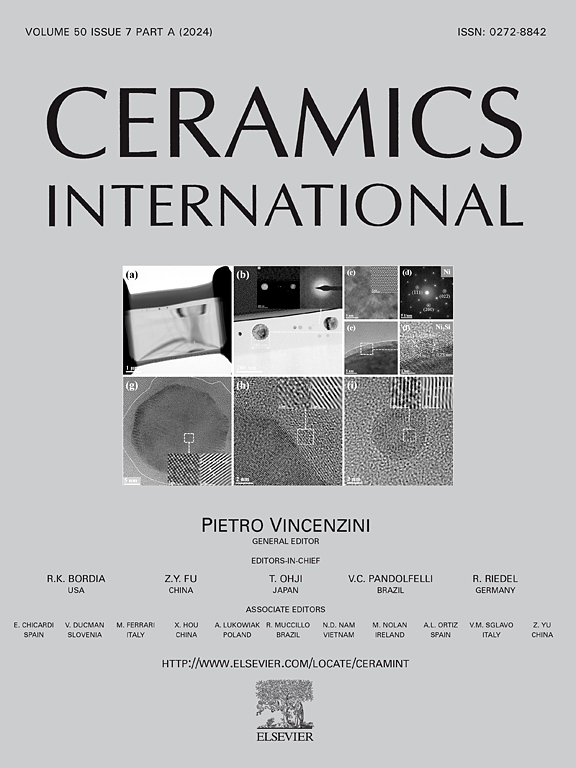Improving thermoelectric properties of high-entropy (Ca0.27Sr0.27Ba0.27La0.19)TiO3-δ ceramics through defect engineering by controlling the oxygen vacancy content
IF 5.1
2区 材料科学
Q1 MATERIALS SCIENCE, CERAMICS
引用次数: 0
Abstract
The current dependence on a singular optimization approach has severely impeded the further enhancement of the performance characteristics of strontium titanate-based thermoelectric materials, thereby significantly hindering their development and practical applications. This study integrates entropy engineering with defect engineering to explore the influence of increased oxygen vacancy concentrations and their interactions with other defects on the microstructure, electrical, and thermal transport properties of high-entropy (Ca0.27Sr0.27Ba0.27La0.19)TiO3-δ ceramics. These ceramics were synthesized using spark plasma sintering (SPS) and subsequently subjected to varying degrees of annealing in a reducing atmosphere. The enhancement of oxygen vacancy concentration within the ceramic did not alter its intrinsic phase structure; however, it had a significant and observable effect on grain growth, porosity, and the formation of dislocation bands. Additionally, the reduction of Ti4+ to Ti3+ was facilitated. These modifications substantially improved the electrical conductivity of the ceramics and accelerated the reduction in thermal conductivity with temperature, thereby promoting the achievement of high ZT values at elevated temperatures. Ultimately, the thermoelectric ceramic demonstrated an impressive power factor of 492 μW/(m·K2) at 1073 K, coupled with a notably low thermal conductivity of 0.31 W/(m·K) and a ZT value of 0.2. This investigation also confirms the existence of an optimal oxygen vacancy concentration that maximizes the thermoelectric performance of the ceramic material. This research underscores the capacity of the combined application of entropy engineering and defect engineering to transcend the confines of conventional single-optimization methodologies, resulting in a marked improvement in the thermoelectric performance of the material across diverse parameters.

求助全文
约1分钟内获得全文
求助全文
来源期刊

Ceramics International
工程技术-材料科学:硅酸盐
CiteScore
9.40
自引率
15.40%
发文量
4558
审稿时长
25 days
期刊介绍:
Ceramics International covers the science of advanced ceramic materials. The journal encourages contributions that demonstrate how an understanding of the basic chemical and physical phenomena may direct materials design and stimulate ideas for new or improved processing techniques, in order to obtain materials with desired structural features and properties.
Ceramics International covers oxide and non-oxide ceramics, functional glasses, glass ceramics, amorphous inorganic non-metallic materials (and their combinations with metal and organic materials), in the form of particulates, dense or porous bodies, thin/thick films and laminated, graded and composite structures. Process related topics such as ceramic-ceramic joints or joining ceramics with dissimilar materials, as well as surface finishing and conditioning are also covered. Besides traditional processing techniques, manufacturing routes of interest include innovative procedures benefiting from externally applied stresses, electromagnetic fields and energetic beams, as well as top-down and self-assembly nanotechnology approaches. In addition, the journal welcomes submissions on bio-inspired and bio-enabled materials designs, experimentally validated multi scale modelling and simulation for materials design, and the use of the most advanced chemical and physical characterization techniques of structure, properties and behaviour.
Technologically relevant low-dimensional systems are a particular focus of Ceramics International. These include 0, 1 and 2-D nanomaterials (also covering CNTs, graphene and related materials, and diamond-like carbons), their nanocomposites, as well as nano-hybrids and hierarchical multifunctional nanostructures that might integrate molecular, biological and electronic components.
 求助内容:
求助内容: 应助结果提醒方式:
应助结果提醒方式:


